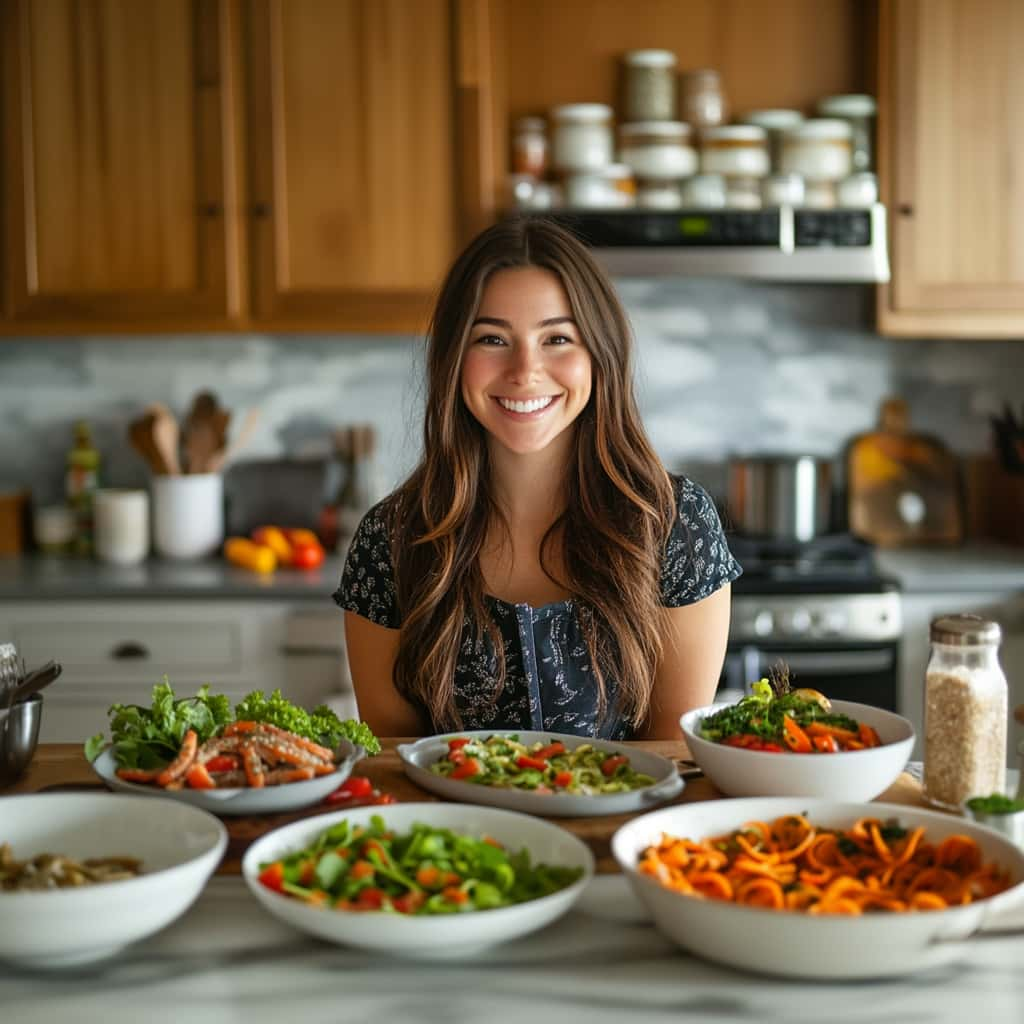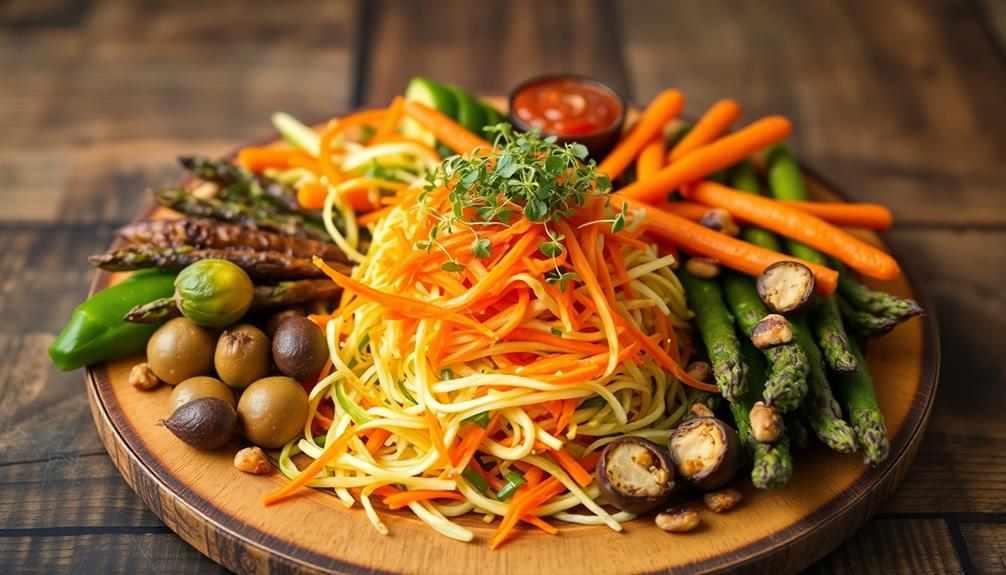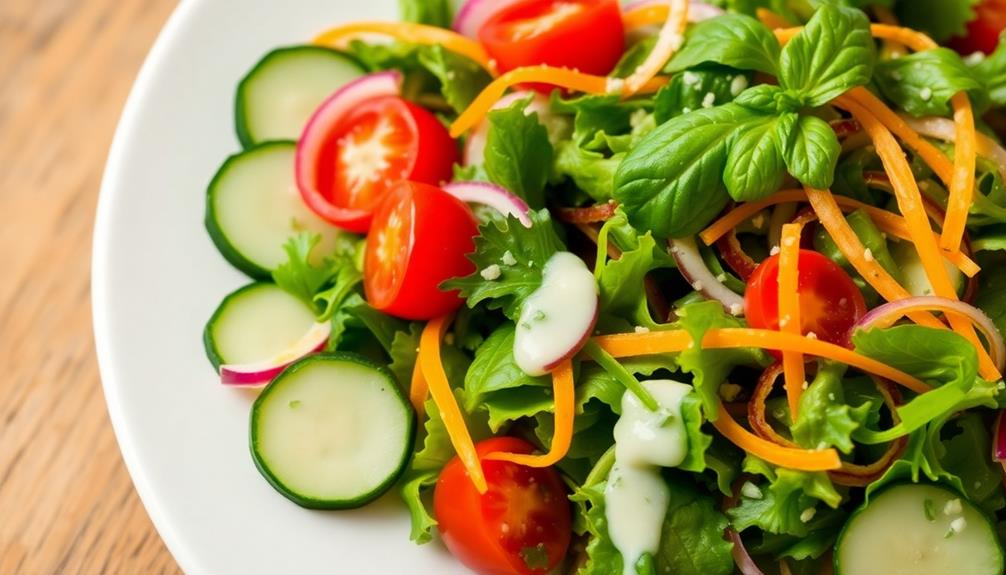Plant-based proteins offer a nutritious and sustainable solution for meeting your body's needs without dairy. Throughout history, civilizations have relied on soy, legumes, and other plant-based protein sources. Today, options like beans, lentils, nuts, and grains provide a diverse array of amino acids, minerals, and antioxidants. Incorporating these versatile ingredients supports muscle growth, digestive health, and overall wellness – often at a lower cost. With the right cooking techniques and recipes, you can craft delicious, protein-packed meals tailored to your personal preferences and lifestyle. Keep reading to discover creative approaches for elevating your plant-based culinary experience.
Key Takeaways
- Plant-based proteins, including beans, lentils, nuts, seeds, and grains, have been part of ancient civilizations' diets, providing sustainable protein sources.
- Diverse plant-based proteins offer a variety of amino acids, minerals, and antioxidants, supporting overall health and wellness without the need for dairy.
- Incorporating plant-based protein can lead to economic benefits, as they are often more affordable than animal-based protein sources.
- Experimentation with different plant-based ingredients and cooking techniques is essential to find suitable protein sources that align with individual dietary needs and preferences.
- Listening to the body's reactions and adjusting the diet accordingly is crucial when transitioning to a plant-based protein-focused diet.
History
The earliest known uses of plant-based protein date back thousands of years, with ancient civilizations like the Aztecs and Chinese incorporating soy, legumes, and other plant-based sources into their diets.
For centuries, people around the world have relied on these nutritious foods to meet their protein needs. As the world's population has grown, so too has the importance of plant-based protein as a sustainable and accessible source of this essential nutrient.
Today, the variety of plant-based protein options has expanded significantly, with an array of beans, lentils, nuts, seeds, and grains available to consumers.
These versatile ingredients can be used in a wide range of dishes, from hearty stews to delicious baked goods.
Whether you're a long-time vegetarian or simply looking to reduce your animal-based protein intake, incorporating more plant-based protein into your diet is a great way to support your overall health and well-being.
Recipe
Protein-packed plant-based dishes are a delicious and nutritious way to nourish your body. This recipe for a savory lentil and vegetable stew isn't only full of flavor but also easy to prepare. Incorporating plant-based meals can also lead to economic benefits and cost savings as they often utilize affordable ingredients like lentils and seasonal vegetables, making them budget-friendly options.
Lentils are a fantastic source of plant-based protein, fiber, and essential nutrients. Combined with a variety of fresh vegetables, this stew delivers a well-balanced and satisfying meal. The blend of spices and herbs infuses the dish with warmth and depth of taste.
- 1 cup brown lentils, rinsed
- 1 onion, diced
- 3 cloves garlic, minced
- 2 carrots, diced
- 2 celery stalks, diced
- 1 bell pepper, diced
- 1 (14.5 oz) can diced tomatoes
- 4 cups vegetable broth
- 2 tsp ground cumin
- 1 tsp dried oregano
- 1 tsp smoked paprika
- Salt and pepper to taste
- Fresh parsley, chopped (for garnish)
In a large pot, sauté the onion and garlic in a bit of water or vegetable broth until softened. Add the carrots, celery, and bell pepper, and continue cooking for 5-7 minutes, stirring occasionally.
Stir in the lentils, diced tomatoes, vegetable broth, cumin, oregano, and smoked paprika. Bring the mixture to a boil, then reduce the heat and simmer for 25-30 minutes, or until the lentils are tender. Season with salt and pepper to taste.
For best results, allow the stew to sit for 10-15 minutes before serving. This allows the flavors to meld together. Garnish with fresh chopped parsley. Enjoy this hearty and nourishing plant-based dish!
Cooking Steps
Grab a bowl and combine your plant-based proteins.
Season them with your favorite spices and herbs to give them a flavorful kick.
Next, sauté some veggies in olive oil until they're tender and fragrant.
Step 1. Combine Plant-Based Proteins in Bowl

Once you have all your plant-based protein sources prepped, it's time to combine them in a bowl. Start by grabbing a medium-sized mixing bowl. This will give you plenty of room to mix everything together without making a mess.
Next, add your cooked lentils, chickpeas, and cubed tofu. These three plant-based proteins pack a powerful nutritional punch, providing a variety of amino acids, fiber, and minerals.
As you add each ingredient, gently stir them together using a large spoon or spatula. This helps distribute the proteins evenly throughout the bowl. Don't be afraid to get your hands in there and give it a good mix if needed.
Once everything is combined, you can season the mixture with your favorite herbs and spices. Try a dash of garlic powder, cumin, and a sprinkle of salt and pepper. This will enhance the flavors and make your plant-based protein bowl even more delicious.
Now you're ready to enjoy this nutritious and satisfying meal!
Step 2. Add Spices and Herbs
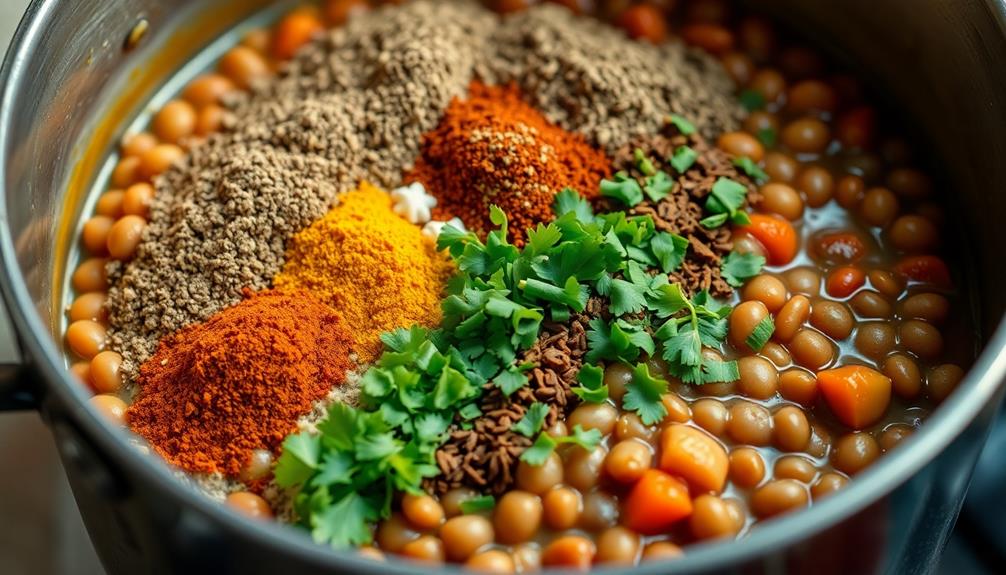
With your plant-based proteins now combined in the bowl, you can start adding some flavorful spices and herbs.
Chia seeds, known for their nutritional benefits, can also enhance the texture and nutritional profile of your dish. This is where you'll really bring out the delicious flavors of your plant-based dish.
Try adding a pinch of cumin, chili powder, and garlic powder to give it a savory, slightly spicy kick. Fresh herbs like cilantro, parsley, or basil will also add a bright, aromatic touch.
For a more earthy flavor, try dried thyme, oregano, or rosemary. Don't be afraid to experiment with different spice blends – find combinations that you enjoy.
The great thing about plant-based cooking is that you can easily customize the seasonings to your taste. Just start with small amounts and add more until you achieve the perfect balance of flavors.
With the right spices and herbs, your plant-based protein bowl will be absolutely bursting with flavor.
Step 3. Sauté Vegetables in Olive Oil
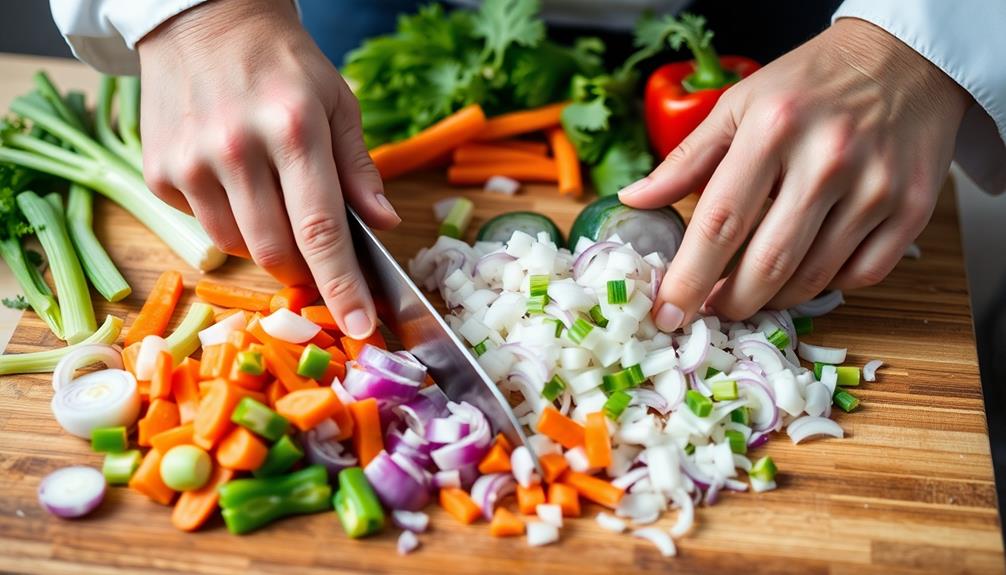
To begin the sautéing process, heat a large skillet or pan over medium-high heat and drizzle in a couple of tablespoons of olive oil.
Once the oil is shimmering, it's time to add your chopped vegetables. You can use a variety of veggies like carrots, bell peppers, zucchini, or mushrooms. Toss them in the oil and let them sizzle, stirring occasionally, until they start to soften and develop a nice golden-brown color, about 5-7 minutes.
As the vegetables cook, you can season them with a pinch of salt, pepper, and any other dried herbs or spices you like, such as garlic powder, onion powder, or Italian seasoning.
This will infuse your veggies with delicious flavor. Keep a close eye on the pan and adjust the heat as needed to prevent burning.
Once the vegetables are tender and caramelized, they're ready to serve as a tasty plant-based side dish or to be incorporated into your favorite recipes.
Step 4. Add Plant-Based Milk
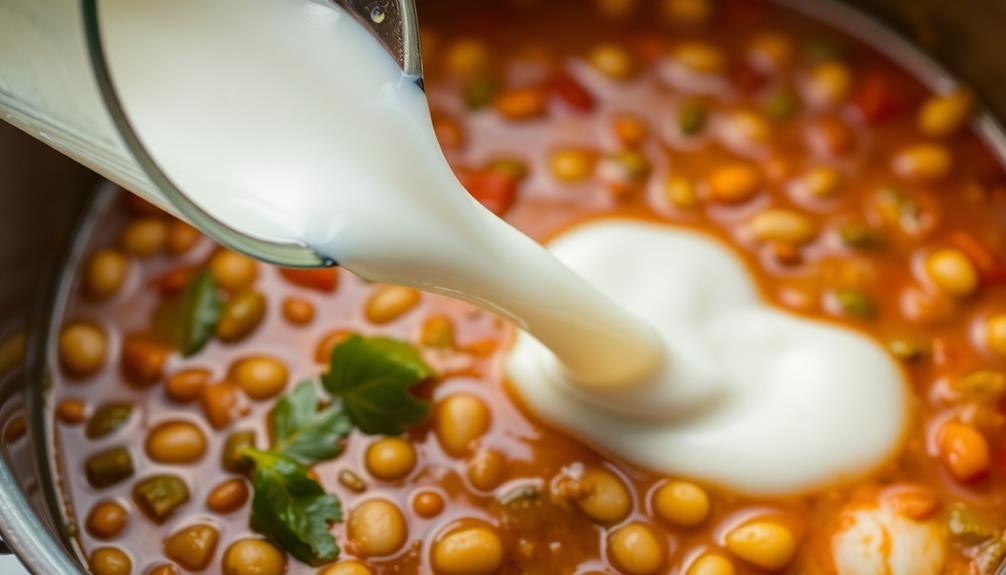
After sautéing the vegetables, you'll want to add some plant-based milk to the pan. This will help create a creamy, flavorful base for your dish. Almond, soy, or oat milk work great – just pour in about 1/2 cup and stir until the milk is well incorporated. The plant-based milk will add a nice richness and creaminess to the vegetables, without the need for dairy.
Additionally, incorporating plant-based options can offer health benefits, such as high levels of antioxidants from ingredients like celery juice or beetroot.
Be sure to heat the milk gently, avoiding boiling, as that can cause it to curdle. Stirring frequently will also help the milk blend seamlessly into the vegetable mixture. Once the milk is heated through, you can season the dish further with salt, pepper, and any other desired spices.
The plant-based milk will nicely complement the sautéed veggies, making for a delicious, dairy-free meal. Feel free to adjust the amount of milk to reach your desired consistency. With just a few simple steps, you've elevated your veggie dish into a nourishing, plant-based creation. To add an extra nutritional boost to your meal, consider incorporating dairyfree probiotics, such as coconut yogurt or fermented tofu, as a topping. These probiotics can help support gut health and digestion, and they will add a creamy texture and tangy flavor to your dish. With the addition of these dairyfree probiotics, you can further enhance the nourishing benefits of your plant-based creation. If you’re looking to increase the calcium content of your meal, consider incorporating dairyfree calcium sources such as fortified plant milks, tofu, and leafy green vegetables like kale and bok choy. These ingredients will not only add a creamy texture and delicious flavor to your dish, but they will also provide essential nutrients for bone health and overall wellness. By incorporating dairyfree probiotics and calcium sources, you can elevate your plant-based creation into a truly nourishing and satisfying meal.
Step 5. Bake in Preheated Oven

Preheat your oven to the specified temperature, typically between 350-425°F, depending on the recipe. This initial step is crucial for ensuring your plant-based baked goods turn out perfectly.
Once the oven's reached the right heat, slide your prepared ingredients into the oven. Bake for the recommended time, keeping a close eye to prevent over-browning. The aroma wafting through your kitchen will be mouthwatering as the flavors develop.
Use oven mitts when removing your creations, as they'll be piping hot. Let them cool for a few minutes before serving. This resting period allows the structure to set, resulting in a delightful texture. Enjoy your freshly baked plant-based treats!
Whether you're making bread, muffins, or cookies, the baking process is the same. Consistency is key, so follow the recipe closely for best results. With a little practice, you'll become a plant-based baking pro in no time.
Final Thoughts
While plant-based proteins offer numerous benefits, it's essential to consider individual dietary needs and preferences when incorporating them into your diet.
Remember, there's no one-size-fits-all approach to nutrition. What works for your friend may not work for you. The key is to experiment and find the plant-based protein sources that make you feel your best.
As you explore the world of plant-based proteins, don't be afraid to get creative! Try new recipes, mix and match ingredients, and find ways to make these proteins work for your lifestyle.
And don't forget to listen to your body – if a certain plant-based protein doesn't sit well with you, don't be afraid to try something else.
Ultimately, the goal is to nourish your body and enjoy the process. With a little bit of experimentation and an open mind, you can discover the plant-based proteins that are perfect for you.
Frequently Asked Questions
How Can Plant-Based Protein Provide Complete Amino Acid Profile?
You can get a complete amino acid profile from plant-based protein by combining different sources like beans, lentils, nuts, and whole grains. This ensures you're getting all the essential amino acids your body needs.
Are Plant-Based Proteins as Bioavailable as Animal-Based Proteins?
You may find that plant-based proteins aren't as bioavailable as animal-based proteins, but with some smart food combining, you can still meet your protein needs. It's all about finding the right balance for your body.
What Are the Benefits of Incorporating Plant-Based Protein Into Diet?
Incorporating plant-based protein into your diet offers several benefits, including increased fiber, reduced cholesterol, and a smaller environmental footprint. It's a versatile and sustainable way to meet your protein needs.
How Does Plant-Based Protein Affect Muscle Growth and Recovery?
You can achieve muscle growth and recovery with plant-based protein. It contains essential amino acids that support muscle building and repair. Plus, it's easier to digest, reducing digestive issues that may hinder your fitness goals.
Can Plant-Based Protein Be Used to Meet Increased Protein Needs?
Absolutely, you can use plant-based protein to meet your increased protein needs. These options provide sufficient amino acids to support muscle growth and recovery, just like animal-based proteins.


